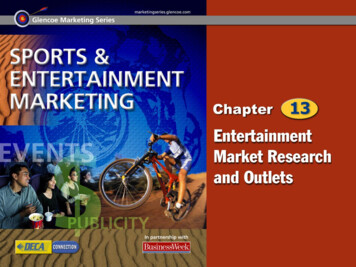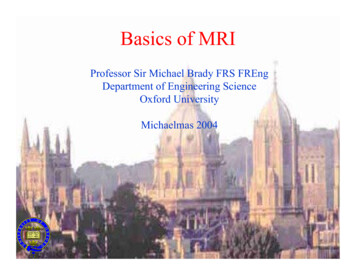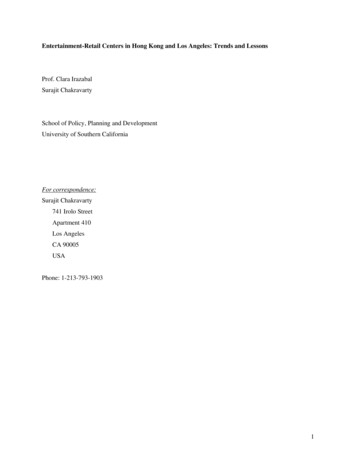
Transcription
Entertainment Engineering& Filmmaking at Mizzou
Filmmaking and Engineering Writing a play is a literary exercise. Producingthe play is an engineering exercise. Filmmaking involves all the same logisticalissues as producing a play -- but with amassive extra layer of complexity. Technology (e.g., for acquiring audio & video,producing digital effects, etc.) is whatdistinguishes film production from theproduction of a play.
“Filmmaking is an exercise inproblem solving ”- Stanley Kubrik
Filmmaking at MizzouThe College of Engineering has producedthree feature films that have screenedaround the world at festivals and in theaters.
Filmmaking at MizzouThe three films involved over 200 students andnumerous faculty from departments across campus.They were funded by the College of Engineering andgrants from the Mizzou Interdisciplinary innovation fund.
Filmmaking at Mizzou“The University of Missouri is one ofthe most academically innovativeschools in the world, and its Collegeof Engineering is especiallyadventurous in providing interestingand challenging applications for itsstudents.[It’s hard] to imagine anywhere elsethat could have pursued these kindsof projects.”- Screem Magazine
Filmmaking at MizzouPreviously, only graduate programs likethe USC's Institute for CreativeTechnologies and Carnegie-Mellon'sEntertainment Technology Center trainedengineering skills required to pursuecareers in Hollywood "magic factories".The biggest difference between themedia engineering programs at otherschools and the one at the University ofMissouri is, of course, [it]’s unbelievablyambitious on-campus movie production.- MovieMaker Magazine
Mil Mascaras vs. the Aztec MummyThis film was the proof-of-conceptproject undertaken by the College ofEngineering.Although overseen by engineeringfaculty, over 100 students and facultyfrom across campus participated inthe effort.
Mil Mascaras vs. the Aztec Mummy
Mil Mascaras vs. the Aztec Mummy
Mil Mascaras vs. the Aztec Mummy
Mil Mascaras vs. the Aztec Mummy
Mil Mascaras vs. the Aztec Mummy
Mil Mascaras vs. the Aztec MummyThe tomb set (below) was constructed in a lab space in anengineering lab in Lafferre Hall. The sculptures on the walls werecreated by a professor and students from the Art department.
Mil Mascaras vs. the Aztec MummyThe film was a high-profile event because it featured the legendaryMexican luchador, Mil Mascaras, with several Hollywood stars.Right is Willard Pughduring filming in JesseHall. He is known forthe Steven Spielbergfilm, The ColorPurple, and actionfilms such as AirForce One (withHarrison Ford) andRobocop II.Other Hollywoodnotables in the filminclude Richard Lynchand PJ Soles.
Mil Mascaras vs. the Aztec MummyIndependent of any publicity for the University, there is no doubtthat everyone involved in the making of a film is motivated by theprospect of getting to see it play at festivals and theaters:
Theatrical Release
Classic Events
Mil Mascaras vs. theAztec Mummy premieredin 2008 at a film festivalin Rio de Janeiro andproceeded to become ahit with critics and fansat festivals around theworld.Since then it has becomean undisputed classicthat continues to attractfestival invitations andmagazine cover articles.Few Hollywood films havesuch long-lasting success.
What the critics sayabout Mil Mascaras vs.the Aztec Mummy:“Amazing movie entertainment Rivals any super hero film madein the mainstream.”Bill Gibron (PopMatters)"Deliriously entertaining."Rating: 'A‘MJ Simpson“Near perfect!” John Porter(FANGORIA)"Thank God for Mil Mascaras!“Richard Harland Smith(Turner Classic Movies)
Academy of DoomThe second film also starred MilMascaras. Unlike the first one,this film was produced in collaboration with the new FilmStudies program.Pre-production and filming wasundertaken by students as a partof a class offered through theComputer Science department,but many more students fromTheatre and other departmentsparticipated on set as actors orproduction assistants.
Academy of Doom
Academy of Doom
Academy of Doom
Academy of DoomStudents by day, flamethrowing actresses by night
Academy of Doom
Academy of DoomAcademy of Doom enjoyed ahighly successful 4-year run onthe international film festivalcircuit, culminating at theprestigious Fantasia International Film Festival inMontreal, Canada, in 2012.Although it was produced withonly a fraction of the budget ofits predecessor, Academy ofDoom proved that a smallbudget can go a long waywhen mixed with studentpassion and ingenuity.
AoD – Behind the Scenes
AoD – Behind the Scenes
AoD – Behind the Scenes
Aztec RevengeThe third film, Aztec Revenge,followed a storyline continued fromthe first film. The production modelwas similar to that of Academy ofDoom except that it also includedcollaborations with students andfaculty from Webster University inSt. Louis, who supported postproduction activities such as audiomixing.This film first screened in 2015 andwas completed in 2016.
Mil Mascaras: Aztec Revenge
Mil Mascaras: Aztec Revenge
Aztec RevengeAztec Revenge enjoyed a highlysuccessful world premiere at theCutreCon International Festival ofMadrid, Spain, in 2015 as part of aspecial two-night celebration of thefilms of Mil Mascaras.According to festival organizers,Mil Mascaras vs. the AztecMummy and Aztec Revenge werethe clear audience favorites.The film was later accepted by theprestigious, Oscar-qualifying, St.Louis International Film Festival.
Aztec RevengeOn July 22, 2017, Mil Mascarasreceived a Lifetime AchievementAward at the Fantasia InternationalFilm Festival in Montreal. AztecRevenge screened after theceremony to an enthusiastic crowd.ABOVE: Mil receives theprestigious Fantasia trophy.LEFT: Mil poses for the media nextto the Aztec Revenge poster.
Aztec Revenge – Behind the Scenes
Aztec Revenge – Behind the Scenes
Aztec Revenge – Behind the Scenes
Movie MagicThis image is from a scene shotin one of the entrances to theHearnes multipurpose building oncampus.Artistic lighting turns a blandconcrete corridor into a visuallyinteresting environment.The complexity to do this is muchgreater than what one mightexpect.
Behind the Scenes
So what do students do? Each of the films began with a film productioncourse. Students in the class oversee all preproduction planning. This requires them toapply their creativity to figure out how to makethe best possible film within the givenbudgetary constraints. At the end of the semester the students in theclass participate in filming. They learn theroles, terminology, etc., for all of the crewpositions. They get hands-on experience withlights, cameras, etc.
So what do students do?In addition to pre-production and working on set duringfilming, students also have the opportunity to work onpost-production activities: Audio-Video courses teach nonlinear editing. Thefilm projects allow students to work with real footagefor real films. Computer Animation courses teach Maya, which isthe Hollywood standard for film special effects (andfor games as well) Media and Digital Effects courses teach special effectstechniques, music composition with loops, and othertopics relevant to games, films, and other multimediaapplications.
Interdisciplinary CollaborationsIn addition to CS/IT, many departments across campusformally collaborated. The following are just a few: The Department of Mechanical Engineering supporteda Capstone project in which students developedspecialized HD-camera equipment. The Theatre Department assisted with casting. The Department of Textile and Apparel Managementassisted with wardrobe. The Department of Architectural Studies assisted withset design. The Department of Student Life assisted with studentparticipation and campus logistics.
Many students who participated in one or more ofthe first three films have said that it was themost exciting and memorable experience of theircollege career.Twenty years from nowthey’ll not only be able totell their children aboutit, they’ll also be ableto show them the film.
“I attended Mizzou looking for anopportunity to pursue both art andscience. To scratch that itch I pursued abachelors degree in both Computer Scienceand Fine Art Ceramics. At times during myundergraduate studies it felt like I wasattending two separate universities becausethere was little opportunity for students from the arts to interact withthose pursuing engineering or science degrees. Through the filmprogram, current Mizzou students have much more opportunityto work together, which provides the students with invaluable realworld experiences and connections.I went on to get my Masters in Computer Science at Mizzou, andI currently work as a software developer at Boeing in St. Louis.Working on the films at Mizzou has given me a leg up in mycareer as an engineer.”- Mike Sullivan
“One of the great things about thefilm program at Mizzou was that itgave me hands-on experience.There are lots of great books aboutfilmmaking, and you read themand you get excited about it, butit's all hypotheticals. Until youactually get your hands dirty in it,you don't really fully experiencewhat it's like to make a movieI think it was really eye-opening for me because I realized what acollaborative art filmmaking truly is. And subsequently after that experienceI started to look at all the different jobs people have and I said okay, well,editing is a component of this that really interests me, and I think this is thepart of filmmaking that I'd like to try and get into after I graduate.”- Doc CrotzerEditor of ‘Glee’
“I had my first real exposure to acting on film inAcademy of Doom. It was nice to be educated as faras what "back to one" means, just how long youshould wait after action is called before you startdoing your thing - and it was really fun learning touse a flamethrower!I always do remember that it started at MU, and itstarted on Academy of Doom, and I've always beenvery grateful for the journey.”- Jolene KayJolene’s experience and leadcredit paved the way for her toland jobs in Hollywood as anactress in high-profilecommercials (e.g., for CocaCola, left) and the occasionalA-list Hollywood film (e.g.,Star Trek, above)
Current & Future ProjectsWe are pursuing relationshipswith other universities andmedia production companies inthe US and abroad to promotefilm-related collaborativeprojects.Multiple collaborative effortshave been initiated in theAfrican country of Zambia,where all three films have airedon television.
Still Popular Demand for the films has not waned. Below shows an audiencewatching one of the films at an October 2019 event in Berlin.
BACKUP SLIDES:THE LUCHA FILM GENRE
Three films have beenproduced at Mizzou.All have starred thelegendary luchador, MilMascaras.(What is a luchador ?Who is Mil Mascaras ?)
What is a luchador ?The modern tradition of themasked luchador was begun inMexico by El Santo – the Manin the Silver Mask.He was a wrestler who resurrected the ancient Aztectradition of the mask andassumed a new identity.“El Santo” was not a fictionalcharacter he played – it washis new real-life identity.
Santo, Blue Demon, and Mil Mascaras areregarded as The Big 3 of the traditionBlue DemonMil Mascaras
The most fascinating aspect of the tradition is that theluchador wears his mask all the time in public. It becomeshis new identity:“When a luchador chooses to give up his own identity andadopt a mask he will begin to see how much of his previouslife was driven by selfish interests [such as] trying to earnthe respect of others instead of just doing what's right.”- Mil Mascaras
El SantoSanto became a legend. Whenhe died in 1984, tens ofthousands of people filled thestreets to mourn his passing.Santo was buried in his silvermask and cape.Statues were erected in hishonor throughout Mexico.
When Blue Demon died in 2000, hewas honored with his picture on theTwenty Pesos note.Like Santo, Blue Demon’s iconicmask was passed to his son, BlueDemon Jr.(The photo to the leftshows Blue Demon Jr at astate function.)The sons of Santo andBlue Demon appearedwith Mil Mascaras in thefilm “Mil Mascaras vs. theAztec Mummy” in 2007.Blue Demon Jr arrives at the National Assembly Hall forPresident Calderon’s State of the Nation address in Mexico City.(Wall Street Journal / Associated Press)
It is important to understandthat luchadores such as Santo,Mil Mascaras, and Blue Demonalways wear their masks.Their masks represent theirtrue identities.
“[On Mexican culture] the most fascinating isthe enduring role of the mask. Masks werepart of Mexican life for centuries before thearrival of the first European. Any goodcorrespondent must try to understand the roleplayed in the Mexican imagination by suchcharacters as El Santo and Mil Mascaras.”From the keynote address byfamed journalist Pete Hamill atthe Images of Mexico in the USMedia Symposium, Feb. 2000.
“Today you cannot understand Mexicowithout understanding Lucha Libre tosee the function of the mask in Mexicanlife, as Octavio Paz has written about.Unless you understand who El Santo wasor Mil Mascaras or Blue Demon you cannotdig deeply into Mexican culture.”From Perceptions andMisconceptions in US-MexicoRelations, published by theWoodrow Wilson Center,Washington, DC (2005).
Lucha FilmsSanto, Mil Mascaras, andBlue Demon starred togetheror separately in over 80films.These films acquired a hugeinternational cult followingbecause of their surrealsensibilities.
Lucha FilmsThe appeal of the luchafilm is that it stars superhero characters whoactually exist.The typical plot of a luchafilm may seem absurd byconventional standards,but it is produced asserious cinema.The lucha genre is unique.
Lucha FilmsKids in Mexico develop great affectionfor lucha films because they grow upwatching them. As they get older,however, they sometimes come tobelieve that the genre is second-ratebecause it is ignored by Hollywood.Outside of Mexico, filmaficionados often regard luchafilms as being more interestingand entertaining than Hollywoodsuperhero films.
Other MediaIn addition to films, lucha characters are featured incomic books that rival DC and Marvel in popularity aroundthe world.
Who is Mil Mascaras?Mil Mascaras – the Man ofa Thousand Masks - is thelast of the Big 3.He is a scholar, wrestler,and accomplished artist.Mil Mascaras revolutionized thetradition with his many maskdesigns.He is an international star andhas served as Mexico’s mostfamous cultural ambassador.
Mexico recently honoredMil Mascaras with threepostage stamps bearingimages from his legendarycareer.Few living people receive such an honor.
Mil Mascaras - Cultural IconMil Mascaras was ared-carpet specialguest at the 2007Imagen Awards(analogous to theNAACP imageawards) ceremonyat the Walt DisneyConcert Hall in LosAngeles, CA.Although he comes from Mexico, his iconic status is notlimited to the Hispanic community and Spanish-speakingcountries. This can be seen from the following slide showing aposter for the 2000 Chiller Convention & Expo at which Milwas a special guest.
Note that Mil isfeatured in thephoto and iscredited (withthe son of ElSanto) aboveScotty fromStar Trek, BillyDee Williamsfrom Star Wars,and Oscarwinner PatriciaNeal.This shows howsignificant the“cool” factor oflucha is and theorganizers’ viewof its appeal to alarge audience.
Why Make Lucha Films?Lasting appeal - Literally thousands of independentfilms are produced each year.The vast majority are completely forgotten shortly afterthey are “released”.The vast majority of non-genre Hollywood films meet thesame fate. That’s why the “franchise factor” has becomeso important in Hollywood.For cultural and cult-aesthetic reasons, lucha films willalways have a dedicated audience. And the filmographiesof Santo and Mil Mascaras will always represent thedefining films of the genre.
The Franchise Factor
Why Make Lucha Films? (cont’d)The franchise/genre appeal opens doors to film festivalsand theatrical distribution.“Mil Mascaras vs. the Aztec Mummy” received numerousfestival invitations even before filming was completed.After popular and critical success on the internationalfestival circuit, the film enjoyed a 300-screen theatricalrelease and numerous special-event screenings. Itcontinues to attract media attention and has appeared onseveral magazine covers within the last year.“Academy of Doom” and “Aztec Revenge” subsequentlyproved that small budgets are no obstacle to popularsuccess at major film festivals.
Filmmaking and Engineering Writing a play is a literary exercise. Producing the play is an engineering exercise. Filmmaking involves all the same logistical issues as producing a play -- but with a massive extra layer of complexity. Technology (e.g., for acquiring audio & video, producing digital effects, etc.) is what










